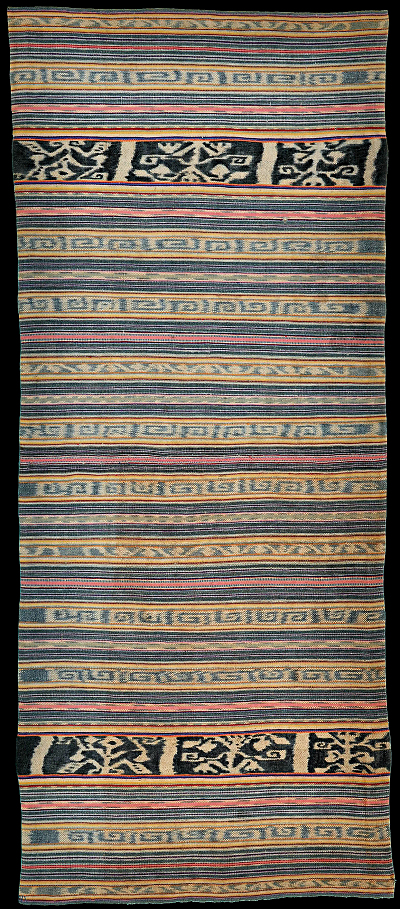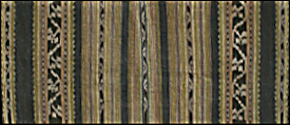| |
 
 | | | |
298 Timor, East Timor
Tais feto (sarong)  
| | Locale: | Viqueque, Tetun people | | Period: | 1910-1930 | | Yarn: | Cotton, hand-spun, medium, and silk pinstripes | | Technique: | Warp ikat | | Panels: | 2 | | Size: | 51 x 121 cm (1' 8" x 3' 11") LW: 2.37 | | Weight: | 450 g (15.9 oz), 365 g/m2 (1.20 oz/ft2) | | Design: | Sarong of a type called rabi walimolu. The main ikated bands carry a floral motif called futus tali. Some of the accent stripes were done in letros, silk, that became unavailable after 1940. The floral patterning, the banded structure with the widest ikated bands close to the extremities, and the colour palette, with its striking violets, are similar to that on a recently made tais kahe, men's shawl, from Viqueque, that was commissioned from a weaver in Ossu by Timor Aid for its collection of classic regional types. The floral pattern is likely to represent a tree of life, as this concept has wide distribution in the archipelago. | | Comment: | All the ikat work was done on fairly coarse hand-spun, all the pinstripes are in letros, silk. The indigo is believed to be natural, the deep black is probably chemical. The overall appearance with its age softened indigo and bright pinstripes in yellow, green and pink and all kinds of purples is decidedly romantic. | | Background: | Chapters on Timor and East Timor. | | Exhibited: | Timor: Totems and Tokens, Museu do Oriente, Lisbon, 2019/20. | | Published: | Timor: Totems and Tokens, 2019.
Ikat Textiles of Timor: Indonesian and Timor-Leste, 2025. | | Sources: | Viqueque origin confirmed by Linda McIntosh and Pierre Dugard. Design similar to that of recent men's shawl, tais kahe in Timor Aid collection, TA0019, detail shown below:
 | | |

©Peter ten Hoopen, 2025
All rights reserved.
|
|


